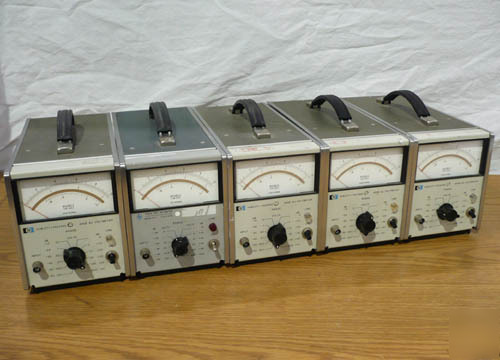Seems ham radio for me is a series of Jones -- you know, those "gotta haves" or "gotta dos'"? Well, my Test Equipment Jones fed into my VTVM Jones and, somewhere along the line, I fantasized about scoring a Heathkit AC voltmeter. (Hey, sorry for all the drug talk; I am a child of the sixties, after all.) Anyway, given that I am also an inveterate and compulsive dilettante, my studies led me to reject that as an option and go for what is more of less the Cadillac of the line: the HP AC voltmeters.
I will spare you all the background save to say that there's a shit-pot full of models made in the 60s though the 80s available at local swaps and on eBay for a relative song. But, before you join in the chorus, take care, lest the melody become harsh and abrading.
There are two distinct models that should attract your attention: "the short ones" and "the long ones". I got both and both came with their own trials and tribulations. The former category is occupied ONLY by the HP 3400AB model (photo shown below).
These are a class act and can be had for anywhere from $20 to $250 -- the lower end requiring and the higher end (usually) coming in a working state and usually calibrated. (Caveat: do NTO even consider the HP 3400B; they're in the high three or low four figutres.) I got two of 'em: one at the TRW swap meet and one off eBay. The former came with the usual swap meet guarantee: "It was working when my uncle's friend's neighbor unplugged it from his work bench back in '03." That's now in the hangar awaiting some new parts. The latter came from a guy in Dallas who said it was working (it was) and was "just out of calibration" (sticker said '93) and allowed for a return if not satisfied. But it was accurate and did work, so I kept it. It's my go-to guy on the bench.
The cool thing about these is that they're real RMS reading voltmeters and they cover a range of [almost} DC to 10 MHz -- and are good up to 20 MHz in a pinch. Also, they will read RMS voltages the same based on almost any waveform. I'd get into it some more, but you're a ham, you do the studying. Here's a great article on these voltmeters and such nonsense like crest factor, etc. I'll wait while you take a moment and read it.
..dum..de.dum.de..dum..de..doodle..de..doo..
O.K., you back? Good!
So now let's talk about the shorties: These are as wide as the HP 3400A but are half as deep and cute as a button -- and there's more varieties of these with more options than you can shake a stick at. Below are stock photos of a 400E, 400F, and 400EL. All have their own characteristics (the "L" means the scales are logarithmic versus linear) and these cover [almost] DC to about 1-2 MHz.
 |
| Various and sundry of HP's collection.. |
Want to test this theory out? Turn on your HP unit and a function generator and throw a 10 KHz sine wave into the meter. Adjust it so it reads, say, one volt RMS. Now switch the function generator to square wave and tell me what happens. Doing the same thing with an HP 3400A will not make the needle flicker. Thus the difference between "true" and "average" responding.
But I digress.
In searching for these meters, I decided that each of the HP 400 series like the ones above offered drawbacks and weren't worth collecting. But then I stumbled onto the HP 403B.
These are small, portable, battery operated AC voltmeters that are widely available, have a simple circuit, and, with a little skill, can be brought back into the land of the living with a modicum of skill.
I found one on eBay that first became a heartbreak and then a pure joy as I solved all of the problems. How I restored this unit will be the subject of one or more subsequent posts. But, it is an instrument that can be put to very good use in tuning up circuits and determining receiver sensitivity.
..so hang in there.
-73-


No comments:
Post a Comment